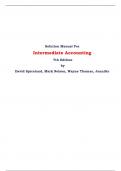Exam (elaborations)
Solution Manual For Intermediate Accounting, 7th Edition by David Spiceland, Mark Nelson, Wayne Thomas, Jennifer
- Course
- Institution
- Book
Solution Manual For Intermediate Accounting, 7th Edition by David Spiceland, Mark Nelson, Wayne Thomas, Jennifer
[Show more]



